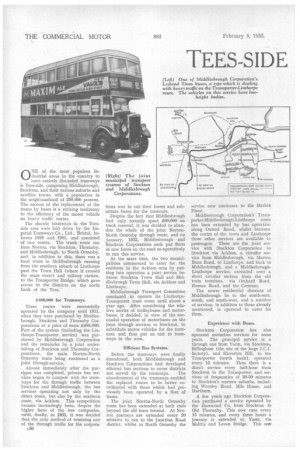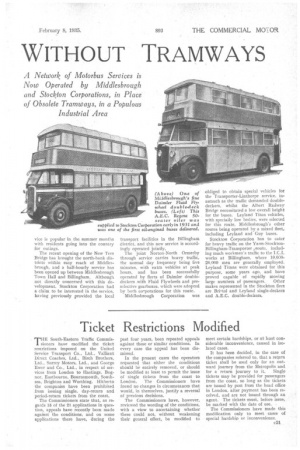TEES-SIDE WITHOUT TRAMWAYS
Page 112

Page 113

If you've noticed an error in this article please click here to report it so we can fix it.
ONE of the most populous industrial areas in the country to have entirely discarded tramways is Tees-side, comprising Middlesbrough, Stockton, and their various suburbs and satellite towns, with a population in the neighbourhood of 250,000 persons. The success of the replacement of the trams by buses is a striking testimony to the efficiency of the motor vehicle on heavy traffic routes.
The electric tramways in the Teesside area were laid down by the Imperial Tramways Co., Ltd., Bristol, between 1898 and 1901, and consisted of two routes. The trunk route ran from Norton, via Stockton, Thornaby, and Middlesbrough, to North Ormesby, and, in addition to this, there was a local route in Middlesbrough running from the southern suburb of Linthorpe past the Town Hall (where it crossed the main route) and railway station, to the Transporter Bridge, which gave access to the districts on the north bank of the Tees.
400,000 for Tramways.
These routes were successfully operated by the company until 1921, when they were purchased by Middlesbrough, Stockton and Thornaby Corporations at a price of some £400,000. Part of the system (including the Linthorpe-Transporter service) was purchased by Middlesbrough Corporation and the remainder by a joint undertaking of .Stockton and Thornaby Corporations, the main Norton-North Ormesby route being continued as a joint through-service.
Almost immediately after the purchase was completed, private bus services began to compete with the tramways for the through traffic between ' Stockton and Middlesbrough, the bus services operating not only by the direct route, but also by the southern route, via Acklam. This competition became increasingly keen, despite the higher fares of the bus companies, finally, in 1,931, it was decided that the only method of retaining any of the through traffic for the corporac50 tions was to cut their losses and substitute buses for the tramcars.
Despite the fact that Middlesbrough had only recently spent £60,040 on track renewal, it was decided to abandon the whole of the joint NortonNorth Ormesby through route, and on January, 1932, Middlesbrough and Stockton Corporations each put fleets of new buses on the road co-operatively to run this service.
At the same time, the two municipalities commenced to cater for the residents in the Acklam area by putting into operation a joint service between Stockton Town Hall and Middlesbrough Town Hall, via Acklam and Linthorpe.
Middlesbrough Transport Committee continued AO operate its LinthorpeTransporter tram route until about a year ago. After considering the relative merits of trolleybuses and motorbuses, it decided, in view of the successful operation of motorbuses on the joint through services to Stockton, to substitute motor vehicles for the tramcars, and thus put an end to tramways in the area.
Efficient Bus Systems.
Before the tramways were finally abandoned, both Middlesbrough and Stockton Corporations had developed efficient bus sections to cover districts not served by the tramways. The abandonment of the tramways enabled the replaced routes to be better coordinated with those which had previously been operated by a fleet of buses.
The joint Norton-North Ormesby route has been extended at both ends beyond the old tram termini. At Norton journeys are extended every 20 minutes to run to the Junction Road district, whilst at North Ormesby the service now continues to the Market Place.
Middlesbrough Corporation's Transporter-Iteliddlesbrough-Linthorpe route has been extended by bus operation along Oxford Road, whilst between the centre of the town and Linthorpe three other services are available to passengers. These are the joint service with Stockton Corporation to Stockton via Acklam, a circular service from Middlesbrough, via Marton Burn Road, to Linthorpe, and back to Middlesbrough, and a MiddlesbroughLinthorpe service, .extended over a short circular section from the old tram terminus, via Orchard Road, Roman Road, and' the Crescent. • The newer residential districts of Middlesbrough lie to the south-east, South, and south-west, and a numbar of services, in addition to those already mentioned, is operated to cater for them.
Experience with Buses.
Stockton Corporation has also operated motorbus services for some years. The principal service is a through one from Yarns, via Stockton, Dillingham (the site of the huge I.C.I. factory), and Haverton Hill, to the Transporter (north bank), operated every 15 minutes. Then there is a direct service every half-hour from Stockton to the Transporter, and services of frequencies of 20-30 minutes to Stockton's western suburbs, including Wensley Road, Mile House, and lartbura.
A few years ago Stockton Corporation purchased a service operated by the Harewood Co, from Stockton to Old Thornaby.. This now runs every 15 minutes, and every three hours a journey is • extended to Yams, via Maltby and Leven Bridge, This ser
vice is popular in the summer months with residents going into the country for outings.
The recent opening of the New Tees Bridge has brought the north-bank districts within easy reach of Middlesbrough, and a half-hourly service has been opened up between Middlesbrough Town Hall and Billingham. Although not directly concerned with this development. Stockton Corporation had a claim to be interested in the service, having previously provided the local (Above) One of Middlesbrough's fine Daimler Fluid Flywheel double-deck buses. (Left) f t) This A.E.C. Regent 50seater oiler was supplied to Stockton Corporation early in 1931 and was one of the first oilrengined buses delivered.
transport facilities in the Billingham district, and this new service is accordingly operated jointly.
The joint Norton-North Ormesby through service carries heavy traffic, the normal day frequency being five minutes. with extra vehicles at peak hours, and has been successfully operated by fleets of Daimler doubledeckers with Fluid Flywheels and preselective gearboxes, which were adopted by both co-potations for this route.
Middlesbrough Corporation was obliged to obtain special vehicles for the Transporter-Linlhorpe service, inasmuch as the traffic demanded doubledeckers. whilst the Albert Railway Bridge necessitated a low overall height for the buses. Leyland Titan vehicles, with speciaily low bodies, were selected for this route, Middlesbrough's other routes being operated by a mixed fleet, including Leyland and Guy buses.
Stockton Corporation has to cater for heavy traffic on the Yarm-StocktonBillingham-Transporter Aroute, including much workmen's traffic to the I.C.I. works at Billingham. where 10,03020,000 men are generally employed. Leyland Titans were obtained for this purpose, some years ago, and have proved capable of rapidly moving large numbers of passengers. Other makes represented in the Stockton fleet are Bristol and Leyland single-deckers and A.E.C. double-deckers.














































































































































































